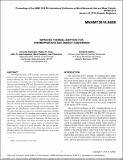Improved Thermal Emitters for Thermophotovoltaic Energy Conversion
Author(s)
Sablon, Kimberly; Stelmakh, Veronika; Chan, Walker R; Joannopoulos, John; Soljacic, Marin; Celanovic, Ivan L.; ... Show more Show less
DownloadImproved thermal emitters.pdf (2.547Mb)
PUBLISHER_POLICY
Publisher Policy
Article is made available in accordance with the publisher's policy and may be subject to US copyright law. Please refer to the publisher's site for terms of use.
Terms of use
Metadata
Show full item recordAbstract
Thermophotovoltaic (TPV) energy conversion enables millimeter scale power generation required for portable microelectronics, robotics, etc. In a TPV system, a heat source heats a selective emitter to incandescence, the radiation from which is incident on a low bandgap TPV cell. The selective emitter tailors the photonic density of states to produce spectrally confined selective emission of light matching the bandgap of the photovoltaic cell, enabling high heat-to-electricity conversion efficiency. The selective emitter requires: thermal stability at high-temperatures for long operational lifetimes, simple and relatively low-cost fabrication, as well as spectrally selective emission over a large uniform area. Generally, the selective emission can either originate from the natural material properties, such as in ytterbia or erbia emitters, or can be engineered through microstructuring. Our approach, the 2D photonic crystal fabricated in refractory metals, offers high spectral selectivity and high-temperature stability while being fabricated by standard semiconductor processes. In this work, we present a brief comparison of TPV system efficiencies using these different emitter technologies. We then focus on the design, fabrication, and characterization of our current 2D photonic crystal, which is a square lattice of cylindrical holes fabricated in a refractory metal substrate. The spectral performance and thermal stability of the fabricated photonic crystal thermal emitters are demonstrated and the efficiency gain of our model TPV system is characterized.
Date issued
2016-01Department
Massachusetts Institute of Technology. Institute for Soldier Nanotechnologies; Massachusetts Institute of Technology. Department of Electrical Engineering and Computer Science; Massachusetts Institute of Technology. Department of PhysicsJournal
Proceedings of the ASME 2016 5th International Conference on Micro/Nanoscale Heat and Mass Transfer, Volume 1: Micro/Nanofluidics and Lab-on-a-Chip; Nanofluids; Micro/Nanoscale Interfacial Transport Phenomena; Micro/Nanoscale Boiling and Condensation Heat Transfer; Micro/Nanoscale Thermal Radiation; Micro/Nanoscale Energy Devices and Systems
Publisher
ASME International
Citation
Stelmakh, Veronika; Chan, Walker R.; Joannopoulos, John D.; Soljacic, Marin; Celanovic, Ivan and Sablon, Kimberly. “Improved Thermal Emitters for Thermophotovoltaic Energy Conversion.” Proceedings of the ASME 2016 5th International Conference on Micro/Nanoscale Heat and Mass Transfer, Volume 1: Micro/Nanofluidics and Lab-on-a-Chip; Nanofluids; Micro/Nanoscale Interfacial Transport Phenomena; Micro/Nanoscale Boiling and Condensation Heat Transfer; Micro/Nanoscale Thermal Radiation; Micro/Nanoscale Energy Devices and Systems V001T05A015 (January 2016): 1-5 © 2016 ASME International
Version: Final published version
ISBN
978-0-7918-4965-1